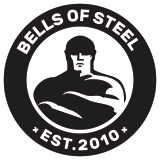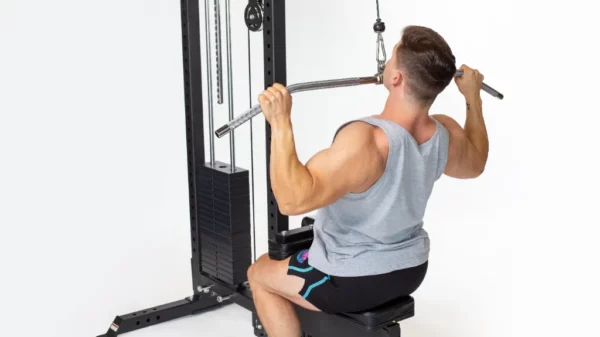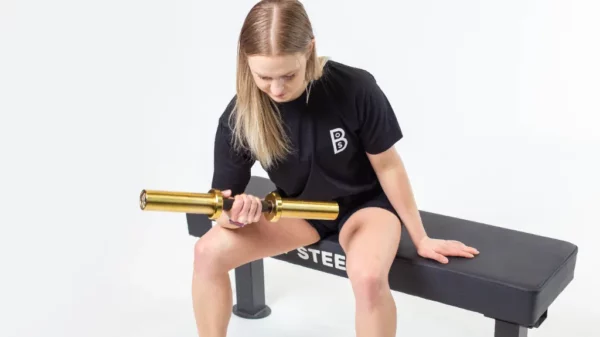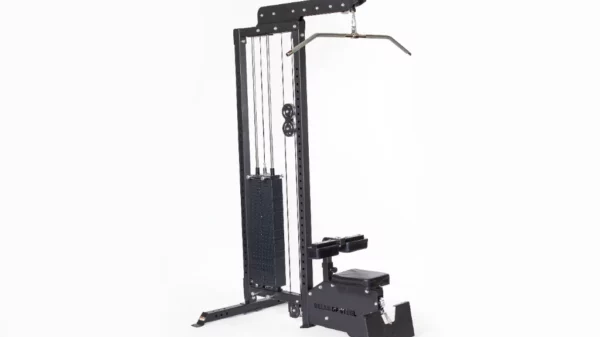Powerlifting is a brutally simple sport that seeks to answer one question:
How much can you squat, bench press, and deadlift?
The simplicity of powerlifting lends itself perfectly for training in your garage home gym. You don’t need all the fancy machines and cardio equipment that a typical commercial gym provides.
In fact, the only fitness equipment you need for a powerlifting home gym is a barbell, squat stands or power rack, a flat bench, and a whole pile of weight plates.
Many of the strongest powerlifters in the world trained by themselves in their garage home gym; often in a dingy basement or even a barn.
So instead of making excuses, spend your time and energy getting stronger in the three power lifts, with your music blasting and chalk flying.
Remember — it’s YOUR home gym, so it’s YOUR rules.
Even better, you don’t have to wait for the squat rack to open up because some kid is taking 15-minute rests scrolling through his phone.
You can even do curls in the squat rack! Just kidding.
Powerlifting Home Gym Equipment
To train the power lifts (the squat, the bench press, and the deadlift) in your garage home gym, you’ll need 4 things:
- Barbell
- Squat Stands or Power Rack
- Flat Bench
- Weight Plates
Barbell
A general-purpose Olympic barbell will work great for your powerlifting garage home gym if you keep a few things in mind.
First, an Olympic barbell simply refers to a barbell that is suitable for serious strength training.
Olympic barbells are usually 7 feet long, weigh 45 pounds, have a 28mm shaft diameter and have sleeves that fit Olympic weight plates — which have a 2-inch center hole.
This design can vary slightly but overall, it makes the barbell more durable, ensures that it will fit correctly in most power racks and it will feel comfortable for almost all people.
Also, pay attention to the knurling. Look for a medium coarseness and ensure that there’s a strip of knurling in the center of the bar to help it stay in place on your back when you’re squatting.
Medium coarseness for the knurling is a great “jack-of-all-trades” level. Too smooth and the bar will slip from your hands when you deadlift. Too coarse and it will chew up your upper back during squats.
Lastly, a high weight capacity is critical. Inferior bars will develop a permanent bend when loads get closer to 500lbs.
Even if you’re not intending to lift that much, a higher weight capacity is often a great indicator of a high-quality, durable barbell. Because of this, aim for a bar with at least a 1,000-pound weight capacity.
Not all barbells are created equal, so take your time and do your research before pulling the trigger.
Squat Stands or Power Rack
To train the squat in your home gym, you can get away with a simple set of squat stands.
This is especially true if you are a high bar squatter and know how to dump a weight that is too heavy.
That said, squat stands have a lower weight capacity and are less stable. This is because they’re designed to be space-efficient, lightweight, and portable.
So, it makes sense to invest in a power rack instead if you’re powerlifting in your garage home gym.
This way, you have spotter bars or straps underneath you if you know that you will often be training alone without a spotter. Plus, you can attempt a new personal record (PR) and not worry about getting pinned with a challenging weight.
Flat Bench
When it comes to training the bench press for powerlifting, a simple flat bench is all you need.
Since you’ll be training heavy, you’ll want to make sure that you have a sturdy bench that doesn’t wobble.
A wobbly bench is not a confidence-builder when you’re gunning for a new PR and is also dangerous — sturdiness is a critical component for any bench.
Proper material to prevent sliding up or down the bench is also key, so pick a bench with grippy upholstery on the pad.
This will make sure that when you’re doing multiple sets of 1-6 reps for your main strength work, you can keep a tight position on the bench which will help keep your technique and force transfer consistent.
Remember that bench pressing alone is inherently dangerous since the bar could suffocate you if you fail a rep and don’t have a backup plan.
To ensure your safety at all times, a power rack is a better choice than squat stands since you can bench press with the spotter bars ready to catch the bar if needed.
Squat stands will support attachable spotter arms but when a bar is placed on the spotter arms, it’s almost guaranteed to cause the squat stands to tip over, so avoid going this route if you want to stay safe.
Weight Plates
You don’t need the most expensive weight plates to build the best home gym setup for powerlifting.
If you’d prefer to have the same diameter for all of your weight plates, then grab a set of bumper plates. They’re reasonably accurate, and they’ll protect your equipment and your floor.
Otherwise, go with a set of cast iron plates (or machined iron plates if you prefer more accuracy) — though you might need a few hundred pounds or more depending on your current strength level.
Powerlifting Home Gym Final Thoughts
Powerlifting is a simple sport, and you don’t have to drop thousands of dollars to get started.
In fact, all you need for your garage home gym is a barbell, squat stands or power rack, a flat bench, and some weight plates.
If you’re looking to build the best home gym setup, you might be interested in our Home Gym Builder — where you can get all your powerlifting home gym equipment at a discounted price.
Check it out below, or click the product links in the sidebar for more details!








